Properties and Performance Verification on Magnetite Polydimethylsiloxane Graphene Array Microwave Sensor
Abstract
:1. Introduction
2. Sensor Design and Fabrication Method
3. Result and Discussion
4. Conclusions
Author Contributions
Funding
Institutional Review Board Statement
Informed Consent Statement
Data Availability Statement
Acknowledgments
Conflicts of Interest
References
- Mosallaei, H.; Sarabandi, K. Antenna miniaturization and bandwidth enhancement using a reactive impedance substrate. IEEE Trans. Antennas Propag. 2004, 52, 2403–2414. [Google Scholar] [CrossRef] [Green Version]
- Sze, J.Y.; Wong, K.L. Bandwidth enhancement of a microstrip-line-fed printed wide-slot antenna. IEEE Trans. Antennas Propag. 2001, 49, 1020–1024. [Google Scholar] [CrossRef]
- Karilainen, A.O.; Ikonen, P.M.; Simovski, C.R.; Tretyakov, S.A. Choosing dielectric or magnetic material to optimize the bandwidth of miniaturized resonant antennas. IEEE Trans. Antennas Propag. 2011, 59, 3991–3998. [Google Scholar] [CrossRef] [Green Version]
- Hwang, Y.; Zhang, Y.P.; Zheng, G.X.; Lo, T.K.C. Planar inverted F antenna loaded with high permittivity material. Electron. Lett. 1995, 31, 1710–1712. [Google Scholar] [CrossRef]
- Huynh, A.; Long, S.; Jackson, D. Effects of permittivity on bandwidth and radiation patterns of cylindrical dielectric resonator antennas. In Proceedings of the 2010 IEEE Antennas and Propagation Society International Symposium, Toronto, ON, Canada, 11–17 July 2010; pp. 1–4. [Google Scholar]
- Isa, M.M.; Langley, R.; Khamas, S.; Isa, A.A.M.; Zin, M.; Johar, F.; Zakaria, Z. Microstrip Patch Antenna Array Mutual Coupling Reduction using Capacitive Loaded Miniaturized EBG. J. Telecommun. Electron. Comput. Eng. 2012, 4, 27–34. [Google Scholar]
- Namin, F.; Spence, T.; Werner, D.; Semouchkina, E. Broadband, Miniaturized Stacked-Patch Antennas for L-Band Operation Based on Magneto-Dielectric Substrates. IEEE Trans. Antennas Propag. 2010, 58, 2817–2822. [Google Scholar] [CrossRef]
- Choi, D.; Choi, M.; Kim, J. Magnetic Properties of Fe@ FeSiAl Oxide Nanoparticles and Magneto-Dielectric Properties of Their Composite Sheets. IEEE Trans. Antennas Propag. 2014, 50, 1–4. [Google Scholar] [CrossRef]
- Attia, H.; Yousefi, L.; Bait-Suwailam, M.M.; Boybay, M.S.; Ramahi, O.M. Enhanced-gain microstrip antenna using engineered magnetic superstrates. IEEE Antennas Wirel. Propag. Lett. 2009, 8, 1198–1201. [Google Scholar] [CrossRef]
- Buell, K.; Mosallaei, H.; Sarabandi, K. A substrate for small patch antennas providing tunable miniaturization factors. IEEE Trans. Microw. Theory Tech. 2006, 54, 135–146. [Google Scholar] [CrossRef] [Green Version]
- Niamien, C.; Collardey, S.; Sharaiha, A.; Mahdjoubi, K. Compact expressions for efficiency and bandwidth of patch antennas over lossy magneto-dielectric materials. IEEE Antennas Wirel. Propag. Lett. 2011, 10, 63–66. [Google Scholar] [CrossRef]
- Hansen, R.C.; Burke, M. Antennas with magneto-dielectrics. Microw. Opt. Technol. Lett. 2000, 26, 75–78. [Google Scholar] [CrossRef]
- Adnan, S.; Abd-Alhameed, R.A.; Hraga, H.I.; Elfergani, I.T.; Child, M.B. Compact Microstrip Antenna Design for Microwave Imaging. In Proceedings of the 2010 Loughborough Antennas & Propagation Conference, Loughborough, UK, 8–9 November 2010. [Google Scholar]
- Hossain, A.; Islam, M.T.; Islam, M.T.; Chowdhury, M.E.H.; Rmili, H.; Samsuzzaman, M. A Planar Ultrawideband Patch Antenna Array for Microwave Breast Tumor Detection. Materials 2020, 13, 4918. [Google Scholar] [CrossRef]
- Raveendran, A.; Sebastian, M.T.; Raman, S. Applications of Microwave Materials: A Review. J. Electron. Mater. 2019, 48, 2601–2634. [Google Scholar] [CrossRef] [Green Version]
- Hossain, T.M.; Jamlos, M.F.; Jamlos, M.A.; Soh, P.J.; Islam, M.I.; Khan, R. Modified H-shaped DNG metamaterial for multiband microwave application. Appl. Phys. A 2018, 124, 183. [Google Scholar] [CrossRef]
- Kilian, A.; Schmidt, L. A novel fabrication process for printed antennas integrated in polymer multi-layer car body panels. In Proceedings of the 2009 European Microwave Conference (EuMC), Rome, Italy, 29 September–1 October 2009; pp. 578–581. [Google Scholar]
- Hage-Ali, S.; Tiercelin, N.; Coquet, P.; Sauleau, R.; Fujita, H.; Preobrazhensky, V.; Pernod, P. A millimeter-wave microstrip antenna array on ultra-flexible micromachined polydimethylsiloxane (PDMS) polymer. IEEE Antennas Wirel. Propag. Lett. 2009, 8, 1306–1309. [Google Scholar] [CrossRef]
- Alqadami, A.S.M.; Jamlos, M.F.; Soh, P.J.; Vandenbosch, G.A.E. Assessment of PDMS technology in a MIMO antenna array. IEEE Antennas Wirel. Propag. Lett. 2015, 15, 1939–1942. [Google Scholar] [CrossRef]
- Chaudhary, S.; Luthra, P.K.; Kumar, A. Use of Graphene as a Patch Material in comparison to the copper and other Carbon Nanomaterials. Int. J. Emerg. Technol. Comput. Appl. Sci. 2013, 3, 272–279. [Google Scholar]
- Barkauskas, J.; Mikoliunaite, L.; Paklonskaite, I.; Genys, P.; Petroniene, J.J.; Morkvenaite-Vilkonciene, I.; Ramanaviciene, A.; Samukaite-Bubniene, U.; Ramanavicius, A. Single-walled carbon nanotube based coating modified with reduced graphene oxide for the design of amperometric biosensors. Mater. Sci. Eng. C 2019, 98, 515–523. [Google Scholar] [CrossRef]
- Islam, M.T.; Samsuzzaman, M.; Kibria, S.; Misran, N. Metasurface Loaded High Gain Antenna based Microwave Imaging using Iteratively Corrected Delay Multiply and Sum Algorithm. Sci. Rep. 2019, 9, 17317. [Google Scholar] [CrossRef] [Green Version]
- Jamlos, M.A.; Jamlos, M.F.; Ismail, A.H. High performance novel UWB array antenna for brain tumor detection via scattering parameters in microwave imaging simulation system. In Proceedings of the 2015 9th European Conference on Antennas and Propagation (EuCAP), Lisbon, Portugal, 13–17 April 2015; pp. 1–5. [Google Scholar]
- Mohammed, B.J.; Abbosh, A.M.; Mustafa, S.; Ireland, D. Microwave System for Head Imaging. IEEE Trans. Instrum. Meas. 2014, 63, 117–123. [Google Scholar] [CrossRef]
- Yang, G.; Xing, X.; Obi, O.; Daigle, A.; Liu, M.; Stoute, S.; Naishadham, K.; Sun, N.X. Loading effects of self-biased magnetic films on patch antennas with substrate/superstrate sandwich structure. IET Microw. Antennas Propag. 2010, 4, 1172–1181. [Google Scholar] [CrossRef]
- Huitema, L.; Reveyrand, T.; Mattei, J.; Arnaud, E.; Decroze, C.; Monediere, T. Frequency tunable antenna using a magneto-dielectric material for DVB-H Application. IEEE Trans. Antennas Propag. 2013, 61, 4456–4466. [Google Scholar] [CrossRef] [Green Version]
- Shin, Y.S.; Park, S.O. A monopole antenna with a magneto-dielectric material and its MIMO application for 700 MHz-LTE-band. Microw. Opt. Technol. Lett. 2010, 52, 2364–2367. [Google Scholar] [CrossRef]
- Lee, J.; Heo, J.; Lee, J.; Han, Y. Design of small antennas for mobile handsets using magneto-dielectric material. IEEE Trans. Antennas Propag. 2012, 60, 2080–2084. [Google Scholar] [CrossRef]
- Ermutlu, M.; Simovski, C.; Karkainen, M.; Ikonen, P.; Sochava, A.; Tretyakov, S. Patch antennas with new artificial magnetic layers. arXiv 2005, arXiv:physics/0504075. [Google Scholar]
- Jamlos, M.A.; Jamlos, M.F.; Khatun, S.; Ismail, A.H. An optimum quarter-wave impedance matching feedline for circular UWB array antenna with high gain performance. In Proceedings of the 2014 IEEE Symposium on Wireless Technology and Applications (ISWTA), Kota Kinabalu, Malaysia, 28 September–1 October 2014; pp. 165–169. [Google Scholar]
- Jamlos, M.A.; Jamlos, M.F.; Ismail, A.H. High performance of coaxial feed UWB antenna with parasitic element for microwave imaging. Microw. Opt. Technol. Lett. 2015, 57, 649–653. [Google Scholar] [CrossRef]
- Graphene Supermarket, Graphene Coatings/Films, Conductive Graphene Sheet. Available online: https://graphene-supermarket.com/Conductive-Graphene-Sheets.html (accessed on 15 June 2015).
- Qin, G.; Qiu, J. Graphene/polypyrrole nanocomposites with high negative permittivity and low dielectric loss tangent. Ceram. Int. 2019, 45, 5407–5412. [Google Scholar] [CrossRef]
- Karim, M.S.B.A.; Konishi, Y.; Kitazawa, T. Robustness analysis of simultaneous determination method of complex permittivity and permeability. In Proceedings of the 2014 International Conference on Numerical Electromagnetic Modeling and Optimization for RF, Microwave, and Terahertz Applications (NEMO), Pavia, Italy, 14–16 May 2014; pp. 1–4. [Google Scholar]
- Karim, M.S.; Konishi, Y.; Harafuji, K.; Kitazawa, T. Determination of Complex Permittivities of Layered Materials Using Waveguide Measurements. IEEE Trans. Microw. Theory Tech. 2014, 62, 2140–2148. [Google Scholar] [CrossRef]
- Muthoosamy, K.; Bai, R.G.; Abubakar, I.B.; Sudheer, S.M.; Lim, H.N.; Loh, H.; Huang, N.M.; Chia, C.H.; Manickam, S. Exceedingly biocompatible and thin-layered reduced graphene oxide nanosheets using an eco-friendly mushroom extract strategy. Int. J. Nanomed. 2015, 10, 1505–1519. [Google Scholar]
- Chen, W.; Yan, L.; Bangal, P.R. Preparation of graphene by the rapid and mild thermal reduction of graphene oxide induced by microwaves. Carbon 2010, 48, 1146–1152. [Google Scholar] [CrossRef]
- Viana, M.M.; Lima, M.C.F.S.; Forsythe, J.C.; Gangoli, V.S.; Cho, M.; Cheng, Y.; Silva, G.G.; Wong, M.S.; Caliman, V. Facile Graphene Oxide Preparation by Microwave-Assisted Acid Method. J. Braz. Chem. Soc. 2015, 26, 978–984. [Google Scholar] [CrossRef]
- Nayan, M.K.A.; Jamlos, M.F.; Lago, H.; Jamlos, M.A. Two-port circular polarized antenna array for point-to-point communication. Microw. Opt. Technol. Lett. 2015, 57, 2328–2332. [Google Scholar] [CrossRef]
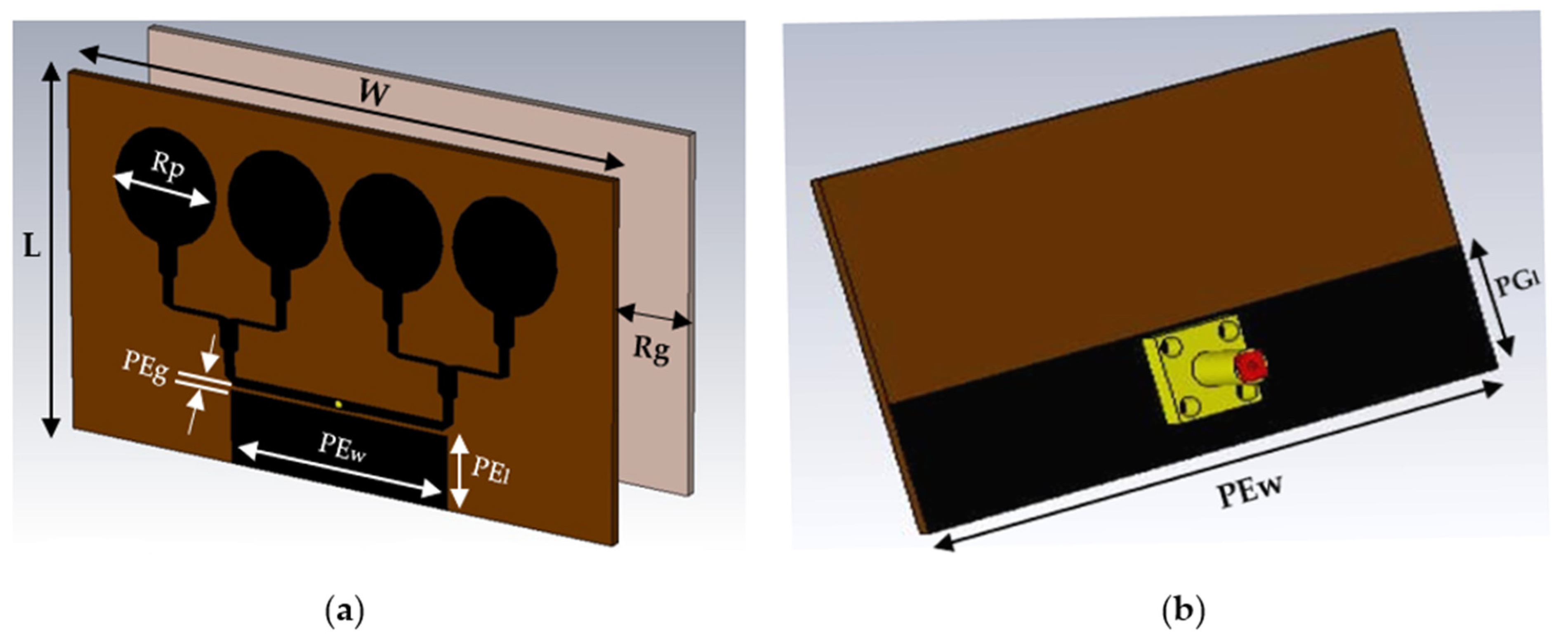



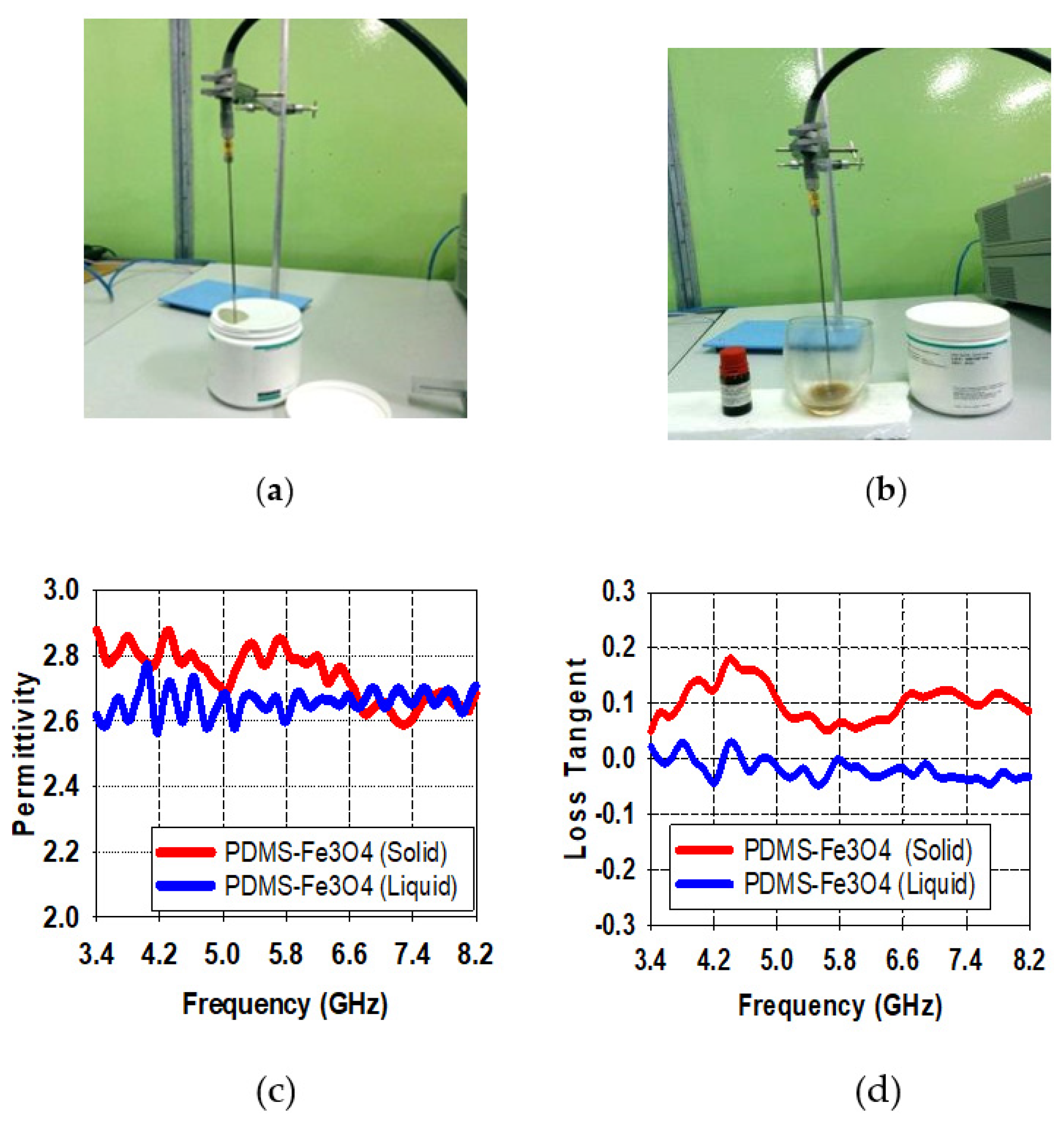


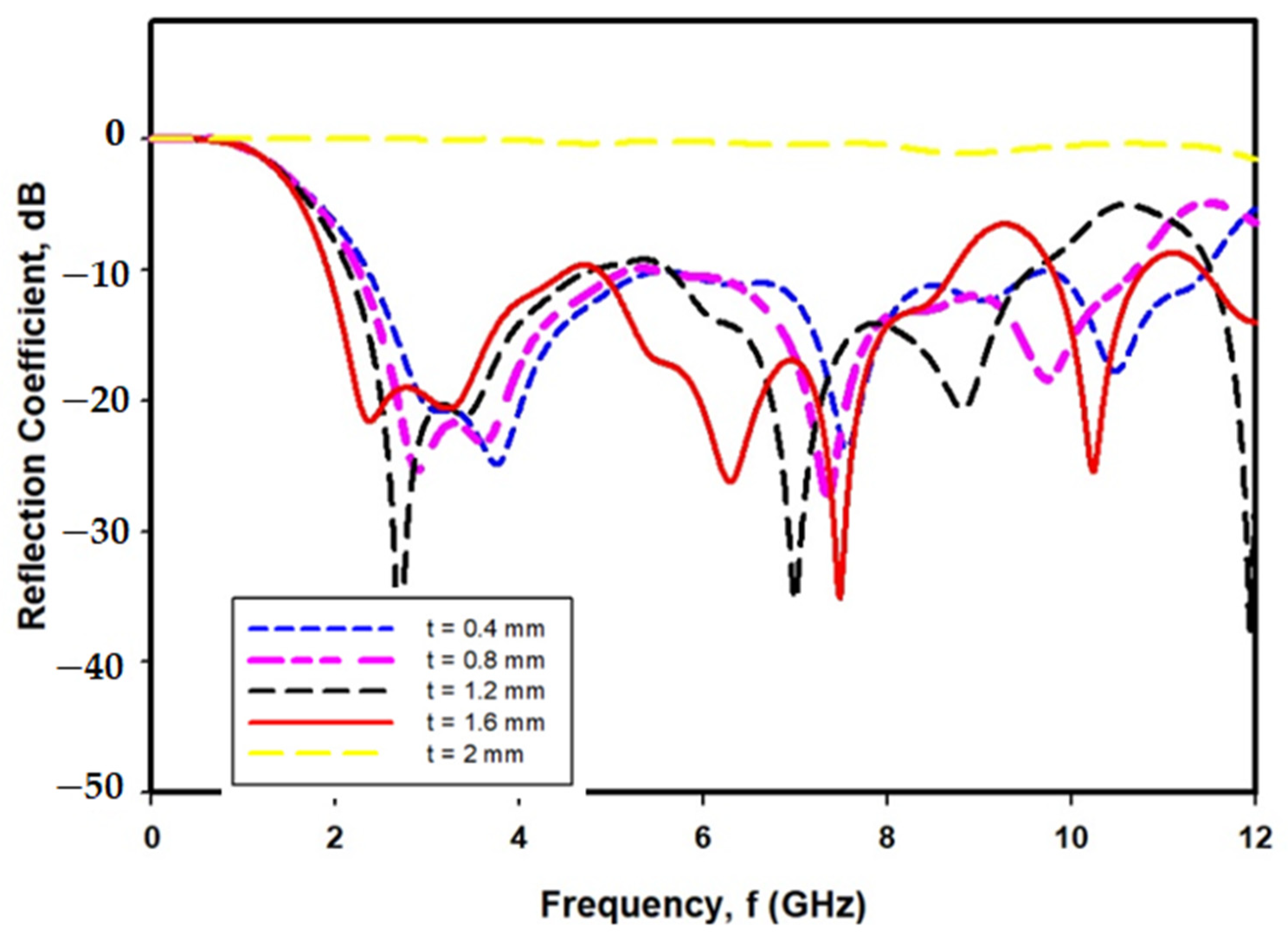

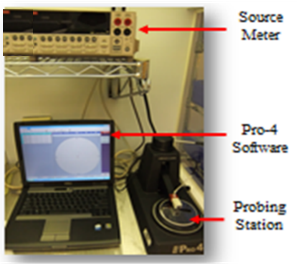
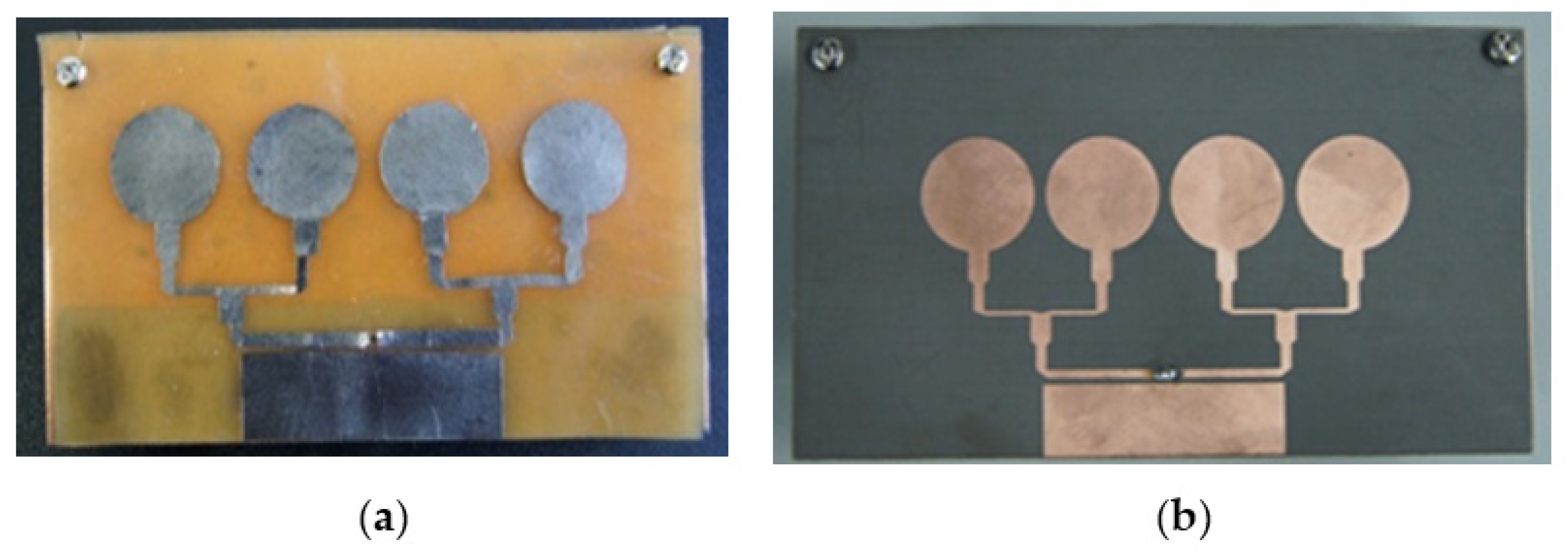
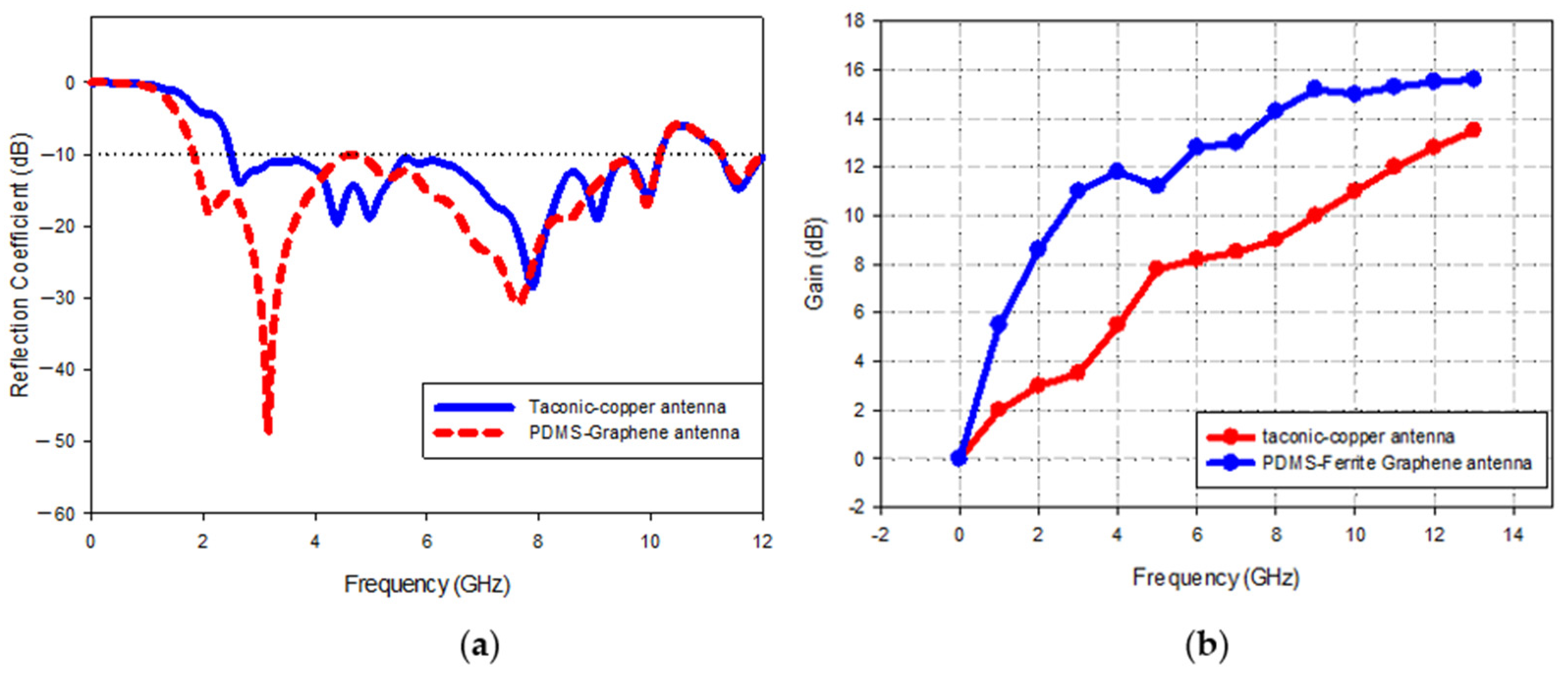

| Ref | Center Frequency (GHz) | Bandwidth (GHz) | Max Gain (dB) |
|---|---|---|---|
| [25] | 2.1 | 0.039 | 2.4 |
| [26] | 0.85 | 0.1 | 5 |
| [27] | 0.8 | 0.077 | 5.1 |
| [28] | 2 | 0.2 | 1.5 |
| [29] | 2.0 | 6 | 5.3 |
| This work (Magnetite PDMS Graphene Array sensor | 4.9 | 9 | 15.7 |
| Parameter | Value (mm) |
|---|---|
| W | 90 |
| L | 45 |
| Rp | 15 |
| PEg | 0.2 |
| PEl | 8 |
| PEw | 30 |
| PGl | 15 |
| PGw | 32 |
| Rg | 20 |
Publisher’s Note: MDPI stays neutral with regard to jurisdictional claims in published maps and institutional affiliations. |
© 2021 by the authors. Licensee MDPI, Basel, Switzerland. This article is an open access article distributed under the terms and conditions of the Creative Commons Attribution (CC BY) license (https://creativecommons.org/licenses/by/4.0/).
Share and Cite
Jamlos, M.A.; Jamlos, M.F.; Alias, A.; Karim, M.S.A.; Mustafa, W.A.; Akkaraekthalin, P. Properties and Performance Verification on Magnetite Polydimethylsiloxane Graphene Array Microwave Sensor. Polymers 2021, 13, 3254. https://doi.org/10.3390/polym13193254
Jamlos MA, Jamlos MF, Alias A, Karim MSA, Mustafa WA, Akkaraekthalin P. Properties and Performance Verification on Magnetite Polydimethylsiloxane Graphene Array Microwave Sensor. Polymers. 2021; 13(19):3254. https://doi.org/10.3390/polym13193254
Chicago/Turabian StyleJamlos, Mohd Aminudin, Mohd Faizal Jamlos, Azri Alias, Mohamad Shaiful Abdul Karim, Wan Azani Mustafa, and Prayoot Akkaraekthalin. 2021. "Properties and Performance Verification on Magnetite Polydimethylsiloxane Graphene Array Microwave Sensor" Polymers 13, no. 19: 3254. https://doi.org/10.3390/polym13193254
APA StyleJamlos, M. A., Jamlos, M. F., Alias, A., Karim, M. S. A., Mustafa, W. A., & Akkaraekthalin, P. (2021). Properties and Performance Verification on Magnetite Polydimethylsiloxane Graphene Array Microwave Sensor. Polymers, 13(19), 3254. https://doi.org/10.3390/polym13193254







